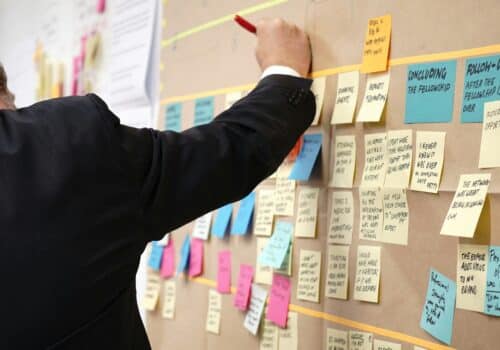Addressing the elephant on the manufacturing floor, Part 1
This is the first in a 3-part series of emails Erin sent out to the Syte mailing list. Manufacturing employment has become such a critical topic, we felt it was important to give context to the challenges and provide a jumping-off point for conversation — so we have decided to publish this email series as articles. As you read this series, we encourage you to reach out to Erin on LinkedIn and share your thoughts and ideas.
I’m coming to you with a challenge that’s been obsessing me … and that I’m stuck on.
In the years that I’ve been working with family-owned manufacturing companies, a lot has changed and become more complex — and technology is only part of it.
As new ERP, IoT and automation technology has rolled out, it has had a ripple effect across the industry and across each business unit within it.
Yet, even with these new opportunities within manufacturing, you may find it surprising to hear that one of the most challenging areas in manufacturing is employment.
While the Syte team may be brought in to help manufacturing companies scale and grow with strategic technology, it’s natural that we end up addressing other issues in the process — because so many things can affect the success of an ERP implementation.
We’ve been able to help many of our clients solve talent challenges over the years, but I want to talk about the elephant in the room today. That is …
Finding enough skilled people is the number one problem for manufacturing companies — and the best ERP on the planet won’t solve this.
I’ve been sitting with this challenge for months, now. I’ve been looking at it from different angles, chewing on it, trying to come up with some way Syte can help in a bigger way, here.
The conclusion that I’ve come to is that there is no neatly packaged solution for this massive problem … and the best thing I can possibly do right now is to kick off this conversation here, with you, and maybe together we can come up with some answers.
This email is an introduction to the massive topic of helping manufacturing companies fill their staffing needs in a way that serves both the company and the employee for the long run.
This will be a three-part series looking at this challenge through the lens of the 3 Cs: connection, collaboration and communication.
Why this lens? Because in my experience, when these three behaviors are intentionally practiced, we always get better results.
I’ve tapped some experts for their advice, and you’ll see them quoted here — and I’m encouraging you to be part of this conversation, too. Once you’ve read through this, share your thoughts and ideas with me. Your voice matters.
Manufacturing Employment: Connecting for Better Outcomes
Deloitte and The Manufacturing Institute conducted a study in recent years that found something startling: The manufacturing skills gap may leave an estimated 2.4 million positions unfilled between 2018 and 2028, with a potential economic impact of $2.5 trillion.
What they also discovered, though, is that a big part of the challenge for manufacturing is understanding how today’s jobs and associated skills are morphing into new career paths that are continuing to evolve along with technology.
From my vantage point, connection is how this understanding will come about — and it’s how we gain alignment in all areas of impact.
- Connecting leadership with employees to clearly understand the current situation
- Connecting people management philosophy with technology development plans
- Connecting job seekers with career paths within manufacturing
- Connecting production employees with the goals of the company to spur engagement and encourage them to look for further opportunities within the company — instead of churning out to other industries
So what does connection look like from a practical standpoint?
A VP of human resources at a large manufacturing company shared with me these thoughts around how they’ve been able to decrease turnover year over year:
“Management needs to be both knowledgeable about and culturally aware of the people on the production floor, and intentionally build relationship. Know people by name and remain visible to increase connection and build trust over time in both directions.”
My recent conversation with a COO at a growing dairy manufacturing company also revealed two key insights around connection.
First, surveys are incredibly powerful tools for connecting with your people — but you have to be willing to hear both positive and (often mostly) negative feedback.
Second, leaders approaching retirement age may be less likely to want to focus on something new (e.g. addressing this rapidly growing skills gap). My takeaway here is this is an opportunity to empower younger and newer managers to take the lead on connecting with employees.
Our own HR expert here at Syte, Judy Moore, shares that while the leadership team should be at the best advantage to understand potential career paths, they must also be connect these roles to the staffing strategy to hire effectively.
Connection is a current that runs deeply through the manufacturing employment challenge — human to human, strategy to execution, current reality to future state, people to technology, job to career path.
With connection we weave a strong web that supports manufacturing companies and employees through transformation and growth.
I want to hear your thoughts, here. Email me — or if it suits you better, schedule a call with me. I’d love to talk more about this with you!
Read the rest of the series here:
ERP Readiness Self-Assessment
Is your organization ready for a new or upgraded ERP solution? Find out with this complimentary self-assessment.
Doing Business Better
You strive for excellence, believe in your people, and want to do things right the first time. And you know that you need help to get to the heart of your business challenges and make the best choices for the future of your privately held manufacturing and distribution company. That’s where we come in.
We help you focus and find exactly the right path to accelerated growth and sustainable success — from your people to your processes to your ERP software.



